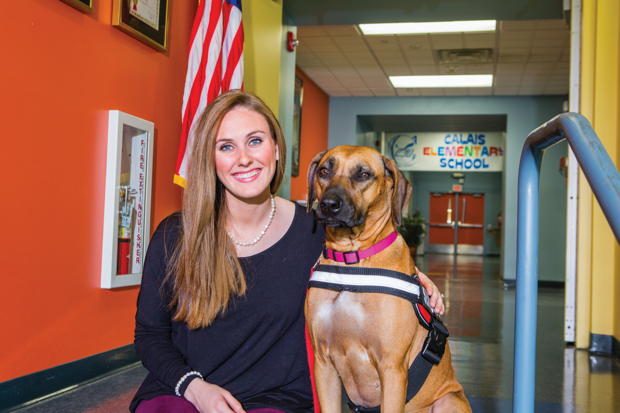
Cali, a 21-month-old Rhodesian ridgeback, sits patiently outside the Calais School in Whippany. This morning, 85 K-12 students will pass through the doors—and Cali will sniff each one. The students know not to pet or distract her while she performs this vital task.
Cali is a trained cortisol detection dog—the first on the staff of any school in the country. Cortisol, also known as the stress hormone, is secreted by human adrenal glands; the rate of secretion rises when people become anxious.
Many of the students at Calais are on the autism spectrum and are prone to anxiety; others have attention deficit disorder or similar challenges that can also trigger anxious moments.
As the children pass by, Cali lets her handler, Casey Butler, know if a student’s cortisol levels are high. Cali’s signals are subtle, but Butler, 25, recognizes when Cali points with her nose and stares at a child. If Cali gives the sign, Butler takes the student aside for some comforting talk and a chance to pet Cali. The goal is to head off any emotional outbursts. Some students even know Cali’s signal and go to Butler on their own.
Merlin’s Kids, a Midland Park-based nonprofit that trains service dogs to work with special-needs children, introduced Cali to the school last year. “Some schools with a special-needs population have service dogs that visit and work with the students as a once-in-a-while activity,” says David Leitner, executive director of the Calais School. “We thought having a service dog on staff would benefit our students.”
Butler, a health teacher at Calais and a certified specialist in natural canine behavior rehabilitation and animal adaptive therapy, was enlisted to train Cali for her special role at the school. During the day, Cali joins Butler in class, where students are allowed to pet and brush the dog. Sometimes they even get to walk her. At night, Cali goes home with Butler.
The students like having Cali nearby. “Cali helps us cope with our problems so that we don’t have to get through it by ourselves,” says one ninth grader.
Cali is well equipped for her job. “Humans have 12 million smell receptors in their nose,” says Nicholas Dodman, director of the Animal Behavior Clinic at Cummings School of Veterinary Medicine at Tufts University. “At the lowest estimate, dogs have 800 million. Scent hounds like beagles and bassets may have up to 4 billion.”
